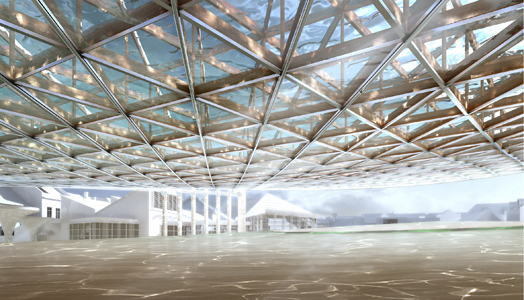Compiled by Anurag
Pandey
Photography:Courtesy the
architects
.jpg) |
| . |
Welcome to Odense, Denmark. In the “little mermaid's tear”, you
will see that renowned storyteller, Hans Christian Andersen’s world of fairy tales
continues to enthrall...
Remember those moments of nostalgic
emotions effectively created by Hans Christian in his fairy tales? While his
fables have touched the world with their prodigious literature; his fancy world
now reaches out beyond the fictional… in his very mansion.
.gif) |
| . |
Architects Liu Yang and Gao Wei have designed Hans
Christian’s house into a museum and children’s playground - with a different
perspective - to bring alive his world of fairy tales, all the way from paper
to pixels to bricks. Inspired by the legendary ‘tear’ of The Little Mermaid
that resonated with Hans’ readers, the duo has created a unique architectural form –a space rendered by pure light and shadow, which integrates the house with its landscape to
create a colourful make-believe world. The place triggers public to reminisce
the virtual wonderland in Hans Christian’s
books through the real world.
.jpg) |
| . |
The building has an underground level, offering a playground for children. The ‘tear’ constructed on the upper level disperses light into this place creating a boundless space like an under ocean world. All exhibition walls, bookshelves, tables and chairs are like ripples centered around the house to make people feel that there are a part of the fairy tales coming out from Hans Christian’s house. The main entrances to the museum and playground are right next to each other under the ‘tear’.
.jpg) |
| . |
Inside, a staircase connects the house to the
playground, which in turn is connected to the underground parking. The idea
here is to connect everything, so that nothing in the city is isolated from the
place, encouraging the public to join in. The structure stands 2,400 sq. m above ground and 7,500 sq. m. below
ground.
 |
| . |
Architecturally, the ‘tear’ is formed by steel suspension mesh
structure, which is supported by three sets of column groups; the underground
is housed by a large wooden wavy roof, where wooden pieces of varying sizes are
connected together by a curved steel beam at a distance of 1500mm. and the
concrete walls under the roof are organized in a ripple pattern around the centre.
Ancient Chinese construction technique called “boiled wax” is used piece-by-piece
to make the wooden underlay waterproof. Wood and glass are bonded
together by using stainless steel skeleton. The water used in
the "Tear" is recyclable and maintained at a constant temperature of
up to 1.5°C.
.jpg) |
| . |
The entire grid is covered with a transparent resin material, which makes the terraced-like roof into a slope, so kids can freely play on it. Transparent resin not only reflects the water shadow from above, but also makes the floor like shining water. When people are in the “tear”, they feel they are in the tear!

How awesome is this! Would love to visit it someday.
ReplyDelete